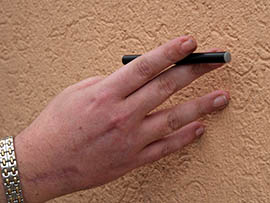Cronkite News has moved to a new home at cronkitenews.azpbs.org. Use this site to search archives from 2011 to May 2015. You can search the new site for current stories.
CDC report: Big increase in nicotine exposure from e-cigarette liquid
PHOENIX – A new report by the Centers for Disease Control and Prevention shows a nationwide rise in nicotine exposure from the liquid in e-cigarettes, mirroring increases seen by Arizona’s poison control centers.
The number of calls nationally rose from one per month in September 2010 to 215 calls per month in February 2014, according to the study released in early April. The study reported 2,405 exposures related to e-cigarettes in this time period but suggests that the number of cases could actually be higher.
“What you see is a pretty constant increase upward of exposures,” Kevin Chatham-Stephens, an epidemiologist with the CDC, said in a telephone interview.
The study found two populations had the greatest number of exposures: children under age 5 (15.1 percent) and those 20 and older (about 42 percent).
Chatham-Stephens said children’s natural curiosity and the candy-like flavors in e-cigarettes can explain their high rate of exposure.
“From a pediatrician’s standpoint, we would encourage people to treat nicotine like any other potentially hazardous chemical in your household,” he said.
According to the CDC, poison centers reported 2,405 e-cigarette and 16,248 cigarette exposure calls from September 2010 to February 2014.
In September 2010, e-cigarettes accounted for 0.3 percent of total month calls involving conventional and electronic cigarettes. By February 2014, e-cigarettes made up 41.7 percent of calls.
Maricopa County is seeing a pattern similar to the national numbers.
“Every year, we have more and more calls to our poison center related to electronic cigarette, or e-cigarette, exposure,” said Dr. Frank LoVecchio, co-medical director of Banner Good Samaritan Poison & Drug Information Center. “The problem with nicotine, of course, is that nicotine concentration is extremely high.”
From January to March, Banner has seen 12 exposures related to e-cigarettes. Seven were children under 2 and four were adults.
In 2013, the center recorded 24 exposures, with 13 cases being children. In 2012, the center had 10 exposures with four children. In 2011, there were four exposures, two involving children.
The study showed that calls involving conventional cigarettes didn’t increase in a similar manner.
The rest of the state also mirrors the nationwide trend, said Dr. Keith Boesen, director of the Arizona Poison & Drug Information Center. The center recorded two calls in 2012, 25 calls in 2013 and 10 calls so far this year.
“Most of the exposures are actually from the liquid itself, like the refill caps, not necessarily the device people are smoking out of,” Boesen said. “It’s the refill where you have a large concentration or quantity of nicotine in a relatively small container.”
The CDC’s Chatham-Stephens said poisoning related to e-cigarettes happens one of four ways, including exposure through the eyes or skin.
“The most common way reported was ingestion and the second most common was inhalation,” he said.
Boesen said the rise in exposure can also be attributed to a perception that e-cigarettes are safer than a conventional cigarette.
“They’re probably less carcinogenic than a cigarette that’s filled with all kinds of other terrible ingredients in there besides the nicotine but I wouldn’t go as far to call them safe,” he said.








